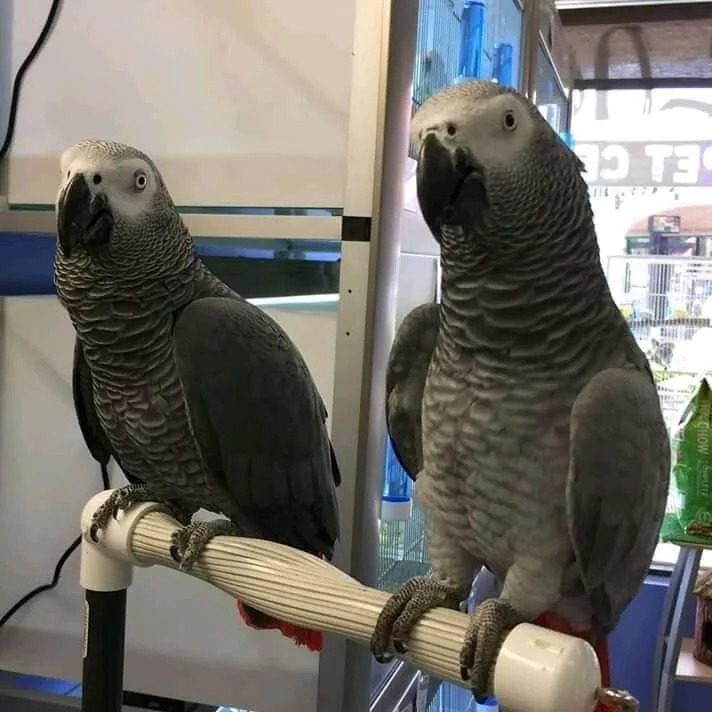
Charming African Grey Parrot For Sale
Thêm một bài đánh giá Theo dõiTổng quan
-
Ngày thành lập 11 Tháng chín, 1941
-
Các ngành Triết học
-
Công việc đã Đăng 0
-
Đã xem 47
Mô tả công ty
10 Best Books On Female African Grey Parrot
The Daughter of a Female African Grey Parrot
The daughter wanted to help her father’s parrot adjust his new life. She tried for a long time to convince him to try new foods and to come out of his cage. But he seemed visibly distressed by his surroundings.
 The best method of determining the distinction between male and female african grey parrot is to perform DNA testing. This method is non-invasive and precise.
The best method of determining the distinction between male and female african grey parrot is to perform DNA testing. This method is non-invasive and precise.
They are very intelligent
The African grey parrot is considered to be one of the smartest birds in the world and can mimic human speech with incredible precision. The species is found in rainforests across central Africa from Cote d’Ivoire to western Kenya. It is a highly social animal, living in large groups and navigating complex relationships in the wild. It is also known to display kindness, for instance, grooming fellow members of the species, or even consuming food for them.
Despite their abilities, African grey parrots are not the easiest pets to care for. They require constant interactions with their human companions and a variety of toys and activities to thrive. Positive reinforcement is the most effective method to motivate desired behavior. They can be taught a variety of tricks and commands. This method involves rewarding desired behavior with treats, praise, or petting. Keep sessions short and fun and be patient while training your bird.
Harvard professor Irene Pepperberg, who worked with Alex the parrot for four decades ago changed the face of animal cognition and linguistics. Her findings, which proved that parrots can perform cognitive tasks beyond that which is observed in humans over 5 years old, are widely accepted to this day.
They are very sociable
Charming African Grey Parrot For Sale grey parrots are famous for their ability to mimic human speech and understand the meaning behind words. They can even tell the distinction between shapes and colors. In the wild, they are monogamous, and they live in tree cavities which are high above ground. They are preyed on by snakes and large cats and defend themselves by fluttering up or biting. They also play an important role in their natural habitat by dispersing undigested seeds.
In captivity, these intelligent animals become very vocal because they are social creatures. It can be difficult to welcome new family members because they tend to get used to one person. They can also have loud vocalizations that could be annoying to family members. These behavior problems can be prevented by educating the bird with treats.
Certain trainers have observed that eliminating the bird from his diet routine can reduce undesirable behaviors, like loud vocalizations. This will encourage him to look for other reward options instead of his regular food. This method takes time and consistency but should decrease the number of unwanted behaviors in the bird’s life.
Many African greys mimic voices and pick up sounds on the radio or from home. They are also good conversation starter and learn to recognize their owners their names.
They are extremely affectionate
African greys are a highly affectionate species and are a great bonding pet for their owners. They are also extremely sensitive and are often receptive to changes in the surroundings or the mood of their owners. They can mimic the sounds they hear, like squeaking doors and windows, backup chimes or vehicle doorbells, microwave oven warnings and ringtones for phones. It is important to pay attention to the sounds they hear, since it can be difficult to get rid of a sound after it becomes part of their vocabulary.
Because of their social lives in the wild, African grey parrots need plenty of stimulation. A bird that is bored or not being taken care of will quickly screech to show its discontent. To prevent this, you should make sure to regularly take your African grey bird out of its cage to play with it.
To ensure your African gray’s long-term happiness and health, it is essential to give it the best care. Make sure that you feed it a high-quality pellet diet designed for parrots. Also, offer fresh fruits and vegetables, which are high in vitamins and minerals. Also, give your bird the opportunity to bathe frequently. It could be as easy as a shower or bowl of water in the bathroom. The bathwater should be kept lukewarm.
They are extremely active
African greys are very active birds that thrive on interaction. They require stimulation frequently otherwise, they’ll get bored and start to cry. Engaging with your pet throughout the day is the best method to prevent this. Talking softly to your parrot, feeding treats and playing with him or her will help you accomplish this. This will help build trust and make the bird more comfortable around humans.
In the wild, African greys forage both in the canopy and on the ground. They eat vegetables, fruits, and seeds. They also consume snails, tree bark and tree bark. They also consume mud and grasses. Parrots have been seen regurgitating food to aid other members of their species. Parrots are also recognized for their vocalizations and mimicking bats, birds and mammals.
Parrots have been known to chase or lunge at predators when they sense danger is close. This is an instinctual defense mechanism to protect their young and other parrots. Parrots can also attack humans if they feel threatened.
These birds are among the most intelligent pets of avian nature. They are able to mimic human sounds and are the most adept at mimicking human voices. They are also able to recognize a wide range of sounds and objects. For instance, they can be taught to recognize the backup chime of a car door or home alarm. They can also respond to microwave alerts as well as telephone ringtones.
They are very social
African grey parrots are a highly social species, flying in large groups and roosting together in the treetops. They live in devoted pairs and exhibit kindness behaviors like grooming one another and regurgitating food to feed the young. In captivity, they can be stressed if their need for social interaction isn’t fulfilled, and may engage in self-harming behaviors such as removing their own feathers.
Their natural curiosity and ability to mimic has led to the idea that they could understand human speech. It is important to keep in mind that African greys do not possess the ability to speak naturally. Their ability to mimic human sounds is due to being held as birds in captivity. They are also frequently seen with their wings clipped, a practice that further isolates them from their family.
If you’re thinking of adopting an African grey, you should consider taking her out of her cage regularly to socialize with family members. This will help reduce agression and feeding behavior. Ideally, you should take your pet out for at least two hours per day.
Positive reinforcement training is the best method to teach your pet to obey commands and listen. Start with basic commands and then gradually increase their complexity. It is also important to train your pet in short sessions to keep them from becoming bored. Make sure you use clear, consistent commands and offer treats during training sessions. This will make the training more rewarding for both of you.
It is easy to train them
Young, hand-raised African Greys adapt well to changes in handling and environmental conditions. However, mature parrots are less open to these changes and may begin to feather pick or become aggressive. The discipline, patience, and hooding (covering the head) are effective methods to change this behavior.
Training your African Grey is an ongoing process. It is important that you train your bird twice per every day for a period of five minutes. This keeps the bird interested and allows for positive reinforcement. It’s also a great time to offer your pet treats, playtime and a little affection. It is not a good idea to reward aggressive behavior.
Parrots are among the most intelligent animals. Fully grown African greys have been compared to the intelligence level of a toddler. They are able to identify, reject, or request categorize and quantify more than 80 different objects. They can also solve puzzles and possess a remarkable ability to solve problems. This is a skill they utilize to help get food out of areas that are difficult to access.
In their natural habitats African grays reside in a variety of lowland forest types, including woodlands, rainforests and Savannahs with wooded areas. They are monogamous, and typically form lifelong pair. They typically roost in groups, sometimes with more than 100 birds. In the wild, these parrots show altruistic behaviours, such as grooming and regurgitating food to feed their family members, and even strangers. They also have a long lifespan and some live up to 60 years.

